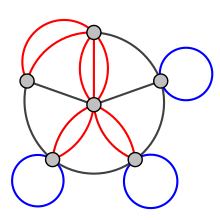In mathematics, a multigraph or pseudograph is a graph which is permitted to have multiple edges, (also called "parallel edges"[1]), that is, edges that have the same end nodes. Thus two vertices may be connected by more than one edge. Formally, a multigraph G is an ordered pair G:=(V, E) with
Multigraphs might be used to model the possible flight connections offered by an airline. In this case the multigraph would be a directed graph with pairs of directed parallel edges connecting cities to show that it is possible to fly both to and from these locations.
Some authors also allow multigraphs to have loops, that is, an edge that connects a vertex to itself,[2] while others call these pseudographs, reserving the term multigraph for the case with no loops.[3]
A multidigraph is a directed graph which is permitted to have multiple arcs, i.e., arcs with the same source and target nodes. A multidigraph G is an ordered pair G:=(V,A) with
- V a set of vertices or nodes,
- A a multiset of ordered pairs of vertices called directed edges, arcs or arrows.
In category theory a small category can be defined as a multidigraph equipped with an associative composition law and a distinguished self-loop at each vertex serving as the left and right identity for composition. For this reason, in category theory the term graph is standardly taken to mean "multidigraph", and the underlying multidigraph of a category is called its underlying digraph.
A mixed multigraph G:=(V,E, A) may be defined in the same way as a mixed graph.

沒有留言:
張貼留言